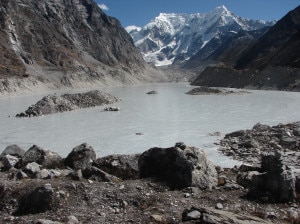Lack of sample causing difficult to estimate Himalayan glaciers

KATHMANDU, Nepal — Although the latest global update on climate change says the vast majority of glaciers worldwide have continued to reduce in size, scientists and mountaineering experts have acknowledged that there was lack of good sample of Himalayan glaciers that could made difficult to forecast their activities.
Glaciologists involved in the cryosphere chapter of the Intergovernmental Panel on Climate Change’s (IPCC) first phase report launched last week, said there was no good sample of Himalayan glaciers that could help them calculate their future behavior, according to BBC.
“The Himalayas are one of the areas we really are data-poor” said Prof David Vaughan from Cambridge University, UK, and one of the two lead coordinating authors of the ice chapter in the Fifth Assessment Report (AR5).
David said that they really required good samples of lots of glaciers. However, the Himalayas received stint coverage in past IPCC reports.
To recall its 3rd Assessment Report in late 2001, the supreme authority on climate science called the Himalayan region mere a “white spot” due to lacking in information. Likewise, its 4th Assessment Report in 2007 brought huge controversy when it mistakenly said that most of the Himalayan glaciers would vanish by 2035. After the IPCC put its hand up on this error, there was an expectation that the fifth report would comprise something more, particularly from the ground. But scientists involved in the latest IPCC report said there had been very little ground-truthing of the satellite imagery obtained for the Himalayas.
“Ground measurements are still very few, and, in addition, these few are usually limited to very small and not very representative glaciers,” said Prof Georg Kaser, a University of Innsbruck, Austria, glaciologist and a lead author on Fifth Assessment Report.
The Himalayas cover about one million square km, and there are more than 15,000 glaciers in the region according to several studies. In the meantime, India’s Wadia Institute of Himalayan is learnt to be monitoring less than half-a-dozen glaciers within the Indian Himalayas according to the latest report. “There are also strategic reasons behind the lack of ground work,” BBC quoted WIHG director Prof Anil Gupta, who was also a review editor on fifth Assessment Report, as a saying.
According to Gupta, China and India, for instance share borders in the Himalayas and so because of the sensitivities on both the sides, it becomes difficult to reach these areas. WIHG has found that one of the reasons behind the recent catastrophic floods in Uttarakhand State of northern India was a brust of a glacial lake.
Prof David has of the opinion that updates on the state of nearby glaciers are crucial for people living in such valleys in the Himalayas. “If you live in a valley below one glacier, you really don’t care what the global average of glacial retreat is; but you just want to know what’s happening to that particular glacier that’s affecting your water security’, David said.
According to the United Nations Environment Programme, there have been at least 35 events of glacial lake outbursts in Nepal, Pakistan, Bhutan and China during the last century. To minimise future risks, Prof David said scientists urgently needed more data on Himalayan glaciers.

